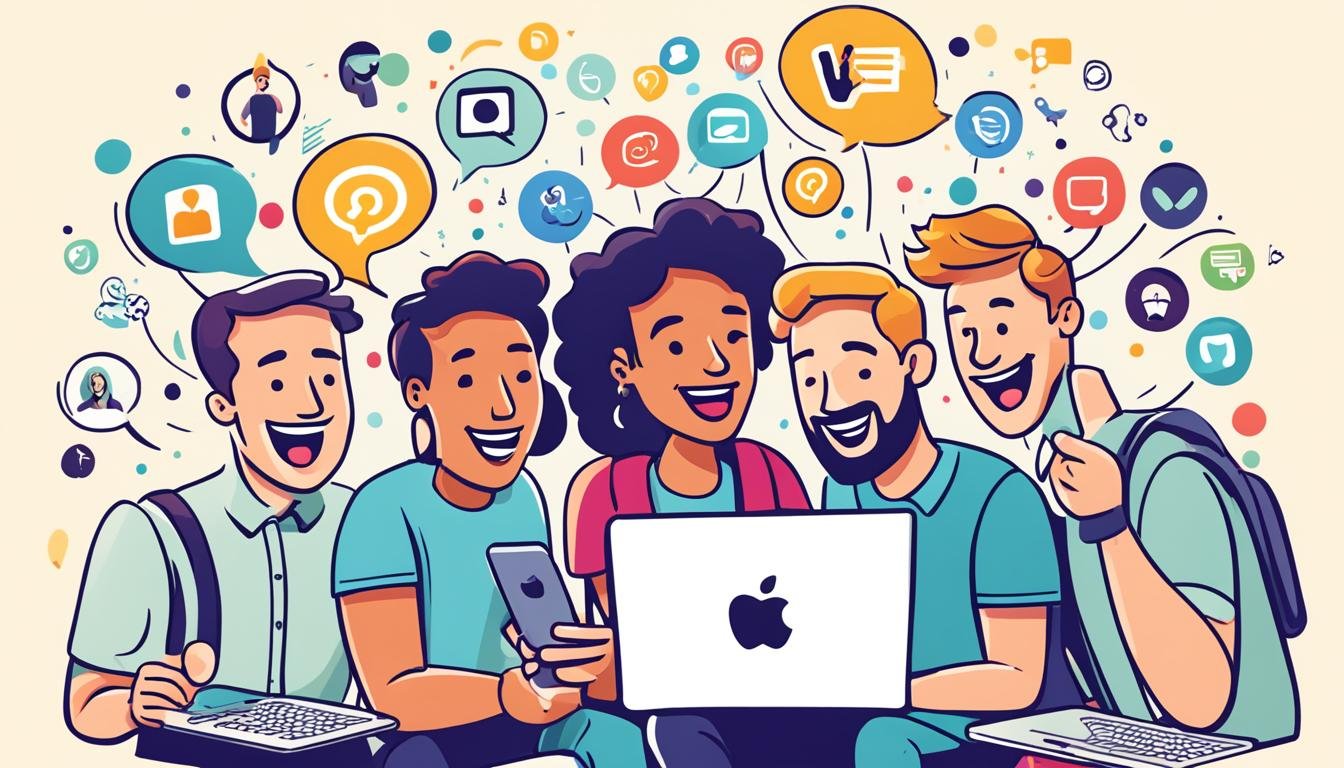The Social Exchange Theory: Building Relationships Online
Did you know that Facebook is the second most-visited website worldwide? It has over 1 billion active users. About half of these users check in every day. This huge online activity is perfect for studying how we form relationships online, linked to the Social Exchange Theory. A study showed a strong link between ‘Reciprocity Likes Received’ and ‘Reciprocity Likes Sent,’ proving the power of reciprocity on Facebook.
The Social Exchange Theory looks at the balance of what we get and what we give in social interactions. It works for all kinds of relationships, like romantic or work ones. People weigh the benefits against the costs of being in a relationship. If the costs are too high, the relationship might end. In the world of online social behavior and virtual relationship dynamics, this theory helps us see why some online friendships last while others don’t.
Key Takeaways:
- Facebook is the second most-trafficked website globally, with over 1 billion active users.
- Approximately 50% of these users log on daily, highlighting the significance of online social behavior.
- A strong correlation of .929 exists between ‘Reciprocity Likes Received’ and ‘Reciprocity Likes Sent.’
- Social Exchange Theory involves a cost-benefit analysis and applies to various relationship types.
- The theory explains why certain online connections succeed while others do not, based on the balance of rewards and costs.
Introduction to Social Exchange Theory
Social Exchange Theory says that relationships are about trading benefits for costs. People look for the best deal they can get. This can be about things like time, money, effort, or getting others to like them. It helps us understand how we connect online and through digital means today.
Definition and Basic Concept
This theory suggests that we make choices in our interactions based on what we get and what we give. Rewards might be things like love, friendship, or help. Costs could be time, effort, or disagreements. It applies to many kinds of relationships, like romantic ones, friendships, or work relationships.
Studies show that getting rewards is key to being happy in relationships, especially for women (Sprecher, 2001).
History and Development
George Homans first introduced the theory in 1961. He later added five main points in 1974. Homans wanted to explain things like power and cooperation. Then, Peter Blau built on this, looking at how institutions work.
Blau’s ideas helped us see how big systems work by looking at individual choices. The idea that we choose who we connect with based on what we get and give helps us understand social behavior. But, some say the theory is too simple, ignoring feelings and culture.
Principles of Social Exchange Theory
Social Exchange Theory has key principles that guide how people interact. These principles help us understand how relationships start and stay strong in social groups.
Cost-Benefit Analysis
At the heart of Social Exchange Theory is cost-benefit analysis. People look at their social interactions to see if they get more good things than bad. They choose to be in relationships that give them more benefits and less costs.
For example, Rusbult (1983) found that college students stay in relationships if they are happy, feel invested, and have good alternatives. So, people look at the total good and bad to decide if they should stay or leave a relationship.
Also, people compare their current relationships with others they could have. This is called comparison levels. As Steve Duck pointed out, what they see in media or how they feel about themselves affects this comparison.
Equity and Reciprocity
Another key idea is equity and reciprocity. Social Exchange Theory says relationships work best when both sides feel they get a fair deal. People exchange things like love, help, money, or services. This balance creates a strong and fair relationship.
Thibaut and Kelley’s model shows how relationships go through different stages. These stages help explain how relationships start, grow, and stay stable. Looking at what might happen in a relationship helps predict if it will be good or bad.
A study looked at 46 articles from places like Social Science Citation Index and Scopus. It showed how these ideas work in many social situations. This proves the theory is strong in explaining how people act in relationships.
Applications of Social Exchange Theory in Online Relationships
George Homans introduced Social Exchange Theory in 1958. It helps us understand online relationships by looking at costs and benefits. People in virtual worlds always check the value of their interactions. This theory shows up clearly in social media, online chats, building communities, and cyber socializing.
Social Media Networking
Social media sites like Facebook, Twitter, and Instagram let us see Social Exchange Theory in action. People decide who to connect with based on what they get back. For example, a “like” or a “comment” can make someone want to keep chatting, making their online connection stronger.
Virtual Interactions and E-Bonding
Virtual chats go beyond just social media. Tools like Zoom and Microsoft Teams help people form deep connections online. These platforms let people bond like they would in real life but over the internet. E-bonding is about exchanging digital favors and support, making the connection stronger over time.
Community Building and Cyber Socialization
Building online communities and cyber socializing are key parts of Social Exchange Theory. Sites like Reddit or LinkedIn let people come together to share and learn. The reward is in the support and resources they share. Cyber socializing keeps these groups lively and rewarding, making people want to keep participating.
George Homans and Peter Michael Blau’s ideas show how online worlds work like real ones. People balance what they give and get to manage their online relationships. This proves Social Exchange Theory is strong in the digital world.
Building Relationships Online with Social Exchange Theory
Social Exchange Theory helps us build digital relationships by seeing online spaces as places for social economy. Here, people weigh the relationship costs and benefits to make meaningful connections. George C. Homans introduced this idea in 1958. He said people judge their relationships by balancing what they give (like money, time, and effort) against what they get (like fun, friends, and support).
John Thibaut and Harold Kelley later added to the theory. They stressed the need to think about costs and benefits. Online, making strong connections means trading value fairly. It’s about putting in emotional effort and making sure the good stuff outweighs the bad.
Peter Blau brought a new view, saying good relationships need more benefits than costs. Bad relationships happen when costs are more. This idea is key online, where we carefully watch our interactions and what we share.
To handle relationship costs and benefits online, try these tips:
- Do things that help both sides.
- Keep exchanges clear and fair to prevent feeling resentful.
- Check how the relationship is doing to keep it valuable.
Using Social Exchange Theory boosts online connections by building trust. It makes sure everyone feels important and supported. Studies like Luthans et al. (2007) show how positive feelings and satisfaction connect.
For digital relationships to work, we need to follow social exchange rules. This means making sure the good stuff always wins, creating a positive online world.
Online Communication: Maximizing Rewards and Minimizing Costs
In today’s digital world, knowing how to communicate online is key to keeping and building strong connections. Social exchange theory shows us how to get the most out of online interactions while keeping costs down. Let’s look at the best ways to do this.
Effective Online Communication Strategies
Good online communication means sending messages that are clear, interesting, and fit the audience. Using sites like Facebook, with over 1 billion users, helps keep interactions positive and consistent. It’s important to balance emotional and time investments to keep costs down. Here are some tips:
- Consistent Engagement: Keeping in touch regularly helps avoid losing touch and keeps the conversation going.
- Personalization: Making messages fit the interests and needs of others builds a stronger connection and boosts positive feedback.
- Utilizing Visuals: Pictures and videos make your messages more memorable and fun.
Maintaining Virtual Rapport
Keeping a good virtual rapport is key in online relationships. It’s not just about how often you talk, but also how well you talk. The social exchange theory says people connect more deeply when they feel the benefits outweigh the drawbacks. Thibaut and Kelley (1959) suggest aiming for interactions that benefit both sides. Here are some tips:
- Positive Reinforcement: Giving positive feedback, like likes or comments, strengthens the connection and encourages more interaction.
- Active Listening: Showing real interest in others’ news and comments by responding well and with empathy helps keep the conversation flowing.
- Reciprocity: Answering others quickly keeps the conversation lively and engaging.
Using these strategies can improve your online rapport, keeping digital costs low while rewards are high. This not only strengthens current relationships but also opens doors to new, meaningful connections online.
The Role of Trust and Intimacy in Internet Relationships
In today’s digital world, trust and intimacy in online relationships are key. They help make online connections work. It’s important to know how these elements work online.
More people use the internet and mobile tech for socializing. Sites like Facebook and Twitter are where many form deep connections. Games like MMORPGs also help build trust by sharing experiences and feelings.
Establishing Trust in Digital Spaces
Building trust online is crucial. A 2019 study looked at trust in online relationships from different fields. It showed trust comes from clear talks and steady actions. For example:
- Clear and open communication enhances trust.
- Consistency in actions reinforces reliability.
- Shared experiences contribute to a sense of loyalty.
Online, we use text, audio, and video to connect. This helps build and keep trust. Studies say online relationships can be as deep and stable as those in real life.
Fostering Intimacy Through Virtual Connections
Building intimacy online means sharing feelings and experiences. Online relationships can feel like real ones, with some perks:
- Enhanced Emotional Connection: Sharing big moments and deep talks can make online bonds stronger.
- Flexibility and Accessibility: Talking anytime, anywhere makes relationships easier to maintain.
A 2022 study found online interactions help teens feel more empathetic and caring. Another review in 2022 talked about the risks of social media. It said it’s important to use these platforms wisely to keep relationships healthy.
In the end, putting effort into trust and intimacy online can lead to rewarding relationships. By understanding these aspects, we can make the most of digital connections.
Managing Costs and Benefits in Digital Connections
When we navigate the digital world, it’s key to balance the costs and benefits of our online interactions. By understanding the different types of rewards and costs, we can make our online presence more rewarding and lasting.
Material vs. Immaterial Rewards and Costs
It’s important to see the difference between material and immaterial rewards in digital connections. Material rewards are things like money, while immaterial rewards are things like feeling supported and recognized. Studies show that too much social media can make us feel lonely and less close to others. But, sharing personal things online can actually make us feel more connected and trusted.
It’s important to find a balance in how we use social media. Being active online can make us feel better about ourselves, but it can also make us feel jealous or alone. Choosing the right kind of support is key to building strong online friendships.
Long-Term vs. Short-Term Gains
Managing our digital connections also means understanding the difference between long-term and short-term gains. Getting likes and comments online can make us feel good right away, but focusing too much on that can harm us in the long run. Research shows that social media can hurt trust and closeness if we’re worried about privacy and jealousy.
But, being active in online communities that feel supportive can lead to lasting benefits. These communities work best when people feel supported and when everyone is fair. This helps us make choices that are good for now and later. Social exchange theory helps us understand how to keep our online relationships strong and satisfying.
In short, managing our digital lives means finding a balance between material and immaterial rewards and between long-term online benefits and quick wins. By making smart choices, we can build lasting and meaningful online connections.
Social Exchange Theory and Online Community Building
Understanding social exchange online communities is key in today’s digital world. Social Exchange Theory explains how people and groups interact online. It helps us see the balance of costs and benefits in virtual community engagement.
This theory uses trust, reciprocity, and shared values to build a supportive online space. Online communities can grow strong when people feel they get something valuable from being part of them.
Online communities are complex, with people weighing the costs against the benefits. For example, 80% of research papers use Social Exchange Theory to study how people behave. This theory is very useful in understanding why people act the way they do in online groups.
It shows how online group dynamics affect how long and well online groups last. Adding social exchanges to marketing can help small businesses do better. As groups use community exchange theory, they always check if being part of the group is good for everyone.
This cycle of interaction makes online communities strong and lively.
Research has looked into how trust and reciprocity work in online groups. For example, offering small rewards for helping out can build trust and get more people involved. This shows how Social Exchange Theory works in online settings.
Looking at online health platforms during the COVID-19 pandemic gives us more clues. Over 1.11 billion people used internet health platforms, showing a big increase in online community interaction. The rise in new users and daily chats shows we’re counting on social exchange to handle online group dynamics.
In short, Social Exchange Theory is a solid base for creating and keeping online communities going. As these spaces change, groups always check if they’re meeting everyone’s goals. This keeps the online world engaging and supportive.
Case Studies: Successful Online Relationship Building
Looking at case studies online relationships gives us real-life examples of how social exchange works online. Dating sites like eHarmony and PlentyOfFish show how millions of people find love online.
Being successful online often depends on how people act. They manage their exchanges, build trust, and get the most out of their relationships. For example, eHarmony uses science to help singles find relationship success. This shows how important it is to communicate well and give and take.
Chernyak-Hai and Rabenu (2018) found that online relationships are getting more complex. They show how managing digital connections works well.
Trust is key in online relationships. Research by Cropanzano and Mitchell (2005) shows that building social exchange case examples is crucial for lasting connections. Like in real life, online friends need to respect and help each other.
Homans (1958) and Gouldner (1960) talked about how giving and getting back is important in relationships. This is true for online relationships too. People look for mutual benefits and reward each other for it.
Looking closer at digital rapport case studies, we see how old social exchange theories still apply online. Studies over the years show how these ideas help keep online relationships going.
Criticisms and Limitations of Social Exchange Theory
Many people question the social exchange theory for its simple view of human relationships. It uses economic ideas like profit and loss to explain love, which might not capture the full emotional picture. This approach might miss the deeper feelings in relationships.
Simplistic Nature of the Theory
A big issue is how the theory simplifies relationships to just trading. Experts like Argyle (1987) say people only think about their relationships when they’re unhappy. This shows that our connections are more complex than just weighing costs and benefits.
The theory also struggles to accurately predict how people act. It focuses too much on what we can see and touch, ignoring feelings that are harder to measure.
Exclusion of Altruism and Selflessness
Another problem is the theory’s lack of focus on giving and selflessness. Critics argue that many relationships are built on unconditional love and giving, not just personal gain. This goes against the idea that everything is about getting something in return, as some studies suggest.
In addition, the theory might not fully capture the emotional side of relationships in close bonds. Research by Christensen et al. (2004) shows that emotional benefits can be more powerful than material gains in relationships.
In summary, while social exchange theory is useful for some relationship studies, it has its limits. It often leaves out the deeper emotional and selfless aspects of human connections.
Conclusion
Social Exchange Theory sheds light on how we connect online. People interact online to get more benefits and avoid costs. These benefits can be anything from material goods to emotional support. Costs include time, effort, and emotional stress.
Everyone expects to get something back in return, thanks to the reciprocity norm. This helps keep interactions balanced. People adjust their actions to keep things fair and positive.
This theory applies to many online situations, like forming communities online. Having a fair share of benefits and costs is key. If things are not fair, it can lead to problems in relationships.
A study with 212 participants looked into online dating, showing how communication and commitment affect relationships. It found strong links between these factors and satisfaction. This study proves Social Exchange Theory is still useful in understanding online relationships.
Even with some critics saying it’s too simple, the theory helps us understand online connections. It shows how important fairness is in our online interactions.
Source Links
- Social exchange in online social networks. The reciprocity phenomenon on Facebook
- Social exchange theory
- Social Exchange in Developing Relationships
- Relationships: Social Exchange Theory
- Social Exchange Theory – FourWeekMBA
- Social Exchange | Encyclopedia.com
- Social Exchange Theory of Relationships: Examples & More
- Social exchange theory: Systematic review and future directions
- Social Exchange Theory – TheoryHub – Academic theories reviews for research and T&L
- Introduction to Social Exchange Theory
- What Is Social Exchange Theory? | Tulane School of Social Work
- Understanding Social Exchange Theory in Psychology
- Online communication and positive psychological capital of college students in China: the mediating role of online social support
- Trust in Social Media: Enhancing Social Relationships
- Online intimacy and well-being in the digital age
- Adolescents and Trust in Online Social Interactions: A Qualitative Exploratory Study
- Understanding online community participation behavior and perceived benefits: a social exchange theory perspective
- Did social exchange theory use with consumer behavior? | 5 Answers from Research papers
- Social Exchange Theory – an overview
- Effectiveness of Interactive Tools in Online Health Care Communities: Social Exchange Theory Perspective
- Frontiers | Social exchange theory: Systematic review and future directions
- What are the criticisms of Social Exchange Theory? | 5 Answers from Research papers
- Understanding The Social Exchange Theory
- Bidding on a “biddie”: Social Exchange and Online Dating







